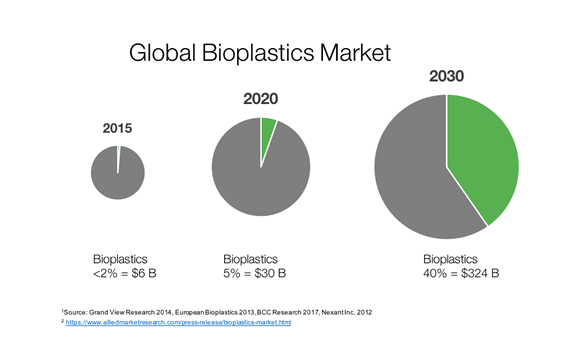Expanded Line of Starch-Based Compostable Resins
Green Dot Bioplastics Terratek BD line has added new grades for single-use and packaging applications.

New film, thermoforming, and injection molding grades have been added by bioplastic materials supplier Green Dot Bioplastics to it Terratek BD line of starch-based compostable resins. Targeted to single-use and packaging applications, this expanded offering is in line with the company’s goal to achieve faster rates of biodegradability in ambient conditions, while meeting the growing sustainability demands of brand owners and consumers. The new materials are an integral part of the company’s extensive bioplastics portfolio which includes biocomposites, elastomers, and natural fiber-reinforced resins all produced at the company’s newly expanded manufacturing facility in Onaga, Kansas.
▪ Five new film grades are compostable starch blends that reportedly require no tooling or process modifications when run on traditional blown or cast film equipment. Among them are Terratek BD3003 which exhibits high puncture resistance and tear strength and is heat sealable like LDPE film. Meanwhile, Terratek BD3300 is a stiff, high-modulus material with high heat resistance and overall properties similar to HDPE film. These grades, said to deliver faster rates of biodegradability for home composting, industrial composting, and soil biodegradability, are targeted for applications such as produce bags, bubble wrap, agricultural films, and other lawn and garden packaging. The film materials are completing third-party certification by TüV Austria, a leading European certifying agency.
▪ Three new thermoforming grades reportedly provide a range of properties including clarity. Other grades provide higher heat performance and greater flexibility for applications such as food service packaging, takeout containers, deli packages, and straws. The thermoforming grades are also completing final certification by TüV Austria.
▪ Two injection molding grades reportedly deliver higher heat performance and enhanced processability (lower cycle times) for caps/closures, food service ware, and takeout containers. In a breakthrough application development effort, Green Dot worked with a customer to commercialize a living hinge design for an injection molded package. Physical and mechanical properties of typical bioplastic resins have not previously allowed the molding of a living hinge capable of hundreds of flexural openings and closures while delivering mechanical properties necessary for a polypropylene-type enclosure.

Said Green Dot Bioplastics’ CEO Mark Remmert,“This launch culminates our extensive development of a new category of compostable materials for single-use applications and packaging markets. We’ve successfully developed unique materials that have a faster rate of biodegradation in ambient composting conditions and the functional performance that the market demands.”
Related Content
-
NPE2024 Materials: Spotlight on Sustainability with Performance
Across the show, sustainability ruled in new materials technology, from polyolefins and engineering resins to biobased materials.
-
Why Are They Blending Biopolymers?
A sit-down with bioplastic producer Danimer Scientific showed me there are more possible answers to that question than I had previously thought.
-
Blend Amorphous PHA with PLA to Improve injection Molded Part Properties
Adding aPHA to PLA can boost a range of mechanical properties and expedite composting. Here are the details as well as processing guidelines for injection molding the blends.














